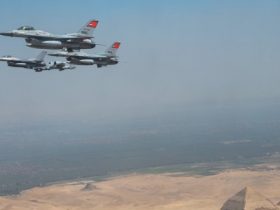The Philippines is seeking to schedule a call with Beijing “very soon” amid an emerging crisis in the South China Sea, according to the Southeast Asia country’s ambassador to the U.S.
At issue is the Sierra Madre, a rusting World War II-era ship run aground on a reef known as the Second Thomas Shoal. The Philippines uses the ship as an outpost and resupplies its soldiers there about once a month.
China considers the area part of its rightful territory — despite a 2016 ruling by the UN Convention on the Law of the Sea to the contrary. The Chinese Coast Guard has long harassed Filipino ships resupplying the post but has recently grown more violent.
Those confrontations escalated on June 17, when Chinese sailors boarded Filipino vessels, jettisoned equipment and injured eight personnel, according to Manila. One lost his thumb, prompting a hospital visit from President Ferdinand Marcos jr, who only weeks earlier warned that he would consider the death of a Filipino citizen “very close” to an act of war.
Such a decision could invoke a mutual defense treaty with Washington and pull American into the conflict. When asked about that possibility in early June, U.S. Secretary of Defense Lloyd Austin said America’s commitment to the treaty was “ironclad” but declined to comment further.
Since the escalation, the Philippines Department of Foreign Affairs has tried to schedule a call with counterparts in China, said Ambassador Jose Manuel Romualdez, speaking with reporters at the embassy in Washington.
That call could occur by early July, he said.
“We have tried all sorts of ways to be able to bring down the level of tension,” he said. “Obviously, most of [those] have not worked and so we feel that perhaps a frank, clear discussion … with the Chinese is probably the best way to go.”
Romualdez also confirmed reporting that the Philippines has reinforced the Sierra Madre — a concern for China, which objects to any attempts to harden the fragile site. That said, the work done so far has been to improve “living conditions” for the soldiers stationed there, the ambassador said.
“As to what we will do down the road if, if that ship starts to fall apart, we don’t know,” said Romualdez. “But again, we have no intention of abandoning” it.
Austin’s outreach
On Wednesday, Austin spoke over the phone with his counterpart in Manila. According to a Pentagon readout of the call, Austin “reaffirmed” America’s support for the Philippines amid the standoff.
In the last year, the two countries have deepened their security relationship. America now has access to four new potential military sites in the Philippines’ north, and a military exercise hosted in the country known as “Balikitan” — or “shoulder to shoulder” in Tagalog — is larger than ever. In April, America deployed a mid-range missile system to the Philippines for the first time, though officials in both countries haven’t specified where it is now.
Despite objections in Beijing, which considers each of these steps a provocation, the Philippines maintains that the new security agreement is defensive.
“It is not going to be used for any kind of offensive situation,” Romualdez said, “unless, of course, the situation calls for it”
In April, the U.S. passed a massive new round of extra security funding, including $4 billion for the Indo-Pacific. Half of that was in long-term arms sales subsidized by the U.S. and another half was to replace Pentagon stocks sent directly to other countries.
Most of that money is headed for Taiwan, but the Philippines will likely get a share. Romualdez said Manila is hoping for a portion of the longer-term Foreign Military Financing and didn’t specify whether his country was seeking a part of the other funding.
“A situation like this calls for decisive action on our part — on all our parts,” he said.
Noah Robertson is the Pentagon reporter at Defense News. He previously covered national security for the Christian Science Monitor. He holds a bachelor’s degree in English and government from the College of William & Mary in his hometown of Williamsburg, Virginia.
Read the full article here

:quality(70)/cloudfront-us-east-1.images.arcpublishing.com/archetype/W3UFL22J6NEIPPRVBYINTAGPQQ.jpg)
:quality(70)/cloudfront-us-east-1.images.arcpublishing.com/archetype/HA5C5Q4NUBAK3HAL7QMOZTQKMI.jpg)

:quality(70)/cloudfront-us-east-1.images.arcpublishing.com/archetype/S4EGEYTSEJDDLDLJSZONQCZC6Y.jpg)

:quality(70)/cloudfront-us-east-1.images.arcpublishing.com/archetype/JS4NYOKBN5BGVEUNSA6W67V574.jpg)
Leave a Reply